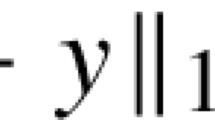Abstract
The majority of research on bilevel programming has centered on the linear version of the problem in which only one leader and one follower are involved. This paper addresses linear bilevel multi-follower programming (BLMFP) problems in which there is no sharing information among followers. It explores the theoretical properties of linear BLMFP, extends the Kth-best approach for solving linear BLMFP problems and gives a computational test for this approach.
Similar content being viewed by others
References
E. Aiyoshi K. Shimizu (1981) ArticleTitleHierarchical decentralized systems and its new solution by a barrier method IEEE Transactions on Systems, Man, and Cybernetics 11 444–449
J. Bard (1984) ArticleTitleAn investigation of the linear three level programming problems IEEE Transactions on Systems, Man, and Cybernetics 14 711–717
J. Bard (1998) Practical Bilevel Optimization: Algorithms and Applications Kluwer Academic Publishers USA
J. Bard J. Falk (1982) ArticleTitleAn explicit solution to the multilevel programming problem Computers and Operations Research 9 77–100
Bialas, W. and Karwan, M. (1978), Multilevel linear programming, State University of New York at Buffalo
W. Bialas M. Karwan (1984) ArticleTitleTwolevel linear programming Management Science 30 1004–1020 Occurrence Handle10.1287/mnsc.30.8.1004
Bialas, W., Karwan, M. et al. (1980), A parametric complementary pivot approach for twolevel linear programming, State University of New York at Buffalo
W. Candler R. Townsley (1982) ArticleTitleA linear twolevel programming problem Computers and Operations Research 9 59–76 Occurrence Handle10.1016/0305-0548(82)90006-5
P. Hansen B. Jaumard et al. (1992) ArticleTitleNew branchandbound rules for linear bilevel programming SIAM Journal on Scientific and Statistical Computing 13 1194–1217
Lu, J., Shi, C. and Zhang, G. (2005), On bilevel multi-follower decision-making: general framework and solutions, Information Sciences (in press), available online at www.sciencedirect.com
Savard, G. (1989), Contributions á la programmation mathématique á deux niveaux, Université de Montréal, École Polytechnique
C. Shi J. Lu G. Zhang (2005) ArticleTitleAn extended Kuhn-Tucker approach for linear bilevel programming Applied Mathematics and Computation 162 51–63 Occurrence Handle10.1016/j.amc.2003.12.089
C. Shi G. Zhang J. Lu (2005a) ArticleTitleOn the definition of linear bilevel programming solution Applied Mathematics and Computation 160 169–176 Occurrence Handle10.1016/j.amc.2003.10.031
C. Shi G. Zhang J. Lu (2005) ArticleTitleAn extended Kth best approach for linear bilevel programming Applied Mathematics and Computation 164 843–855 Occurrence Handle10.1016/j.amc.2004.06.047
Stackelberg, H. V. (1952), The Theory of the Market Economy, Oxford University Press
D. White G. Anandalingam (1993) ArticleTitleA penalty function approach for solving bilevel linear programs Journal of Global Optimization 3 397–419 Occurrence Handle10.1007/BF01096412
Author information
Authors and Affiliations
Corresponding author
Rights and permissions
About this article
Cite this article
Shi, C., Zhang, G. & Lu, J. The Kth-Best Approach for Linear Bilevel Multi-follower Programming. J Glob Optim 33, 563–578 (2005). https://doi.org/10.1007/s10898-004-7739-4
Issue Date:
DOI: https://doi.org/10.1007/s10898-004-7739-4




